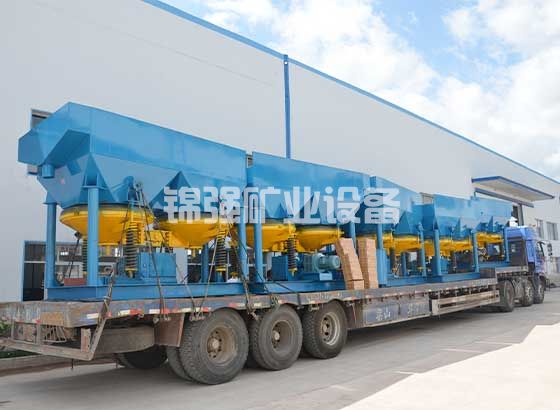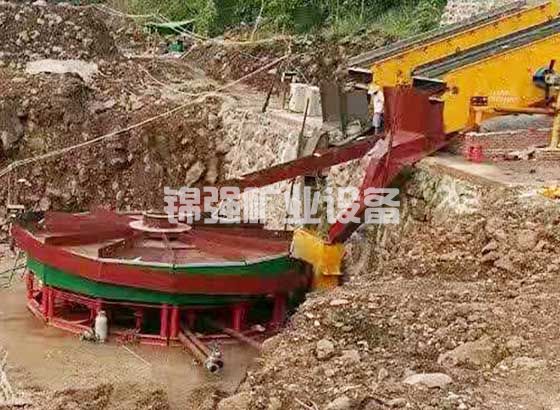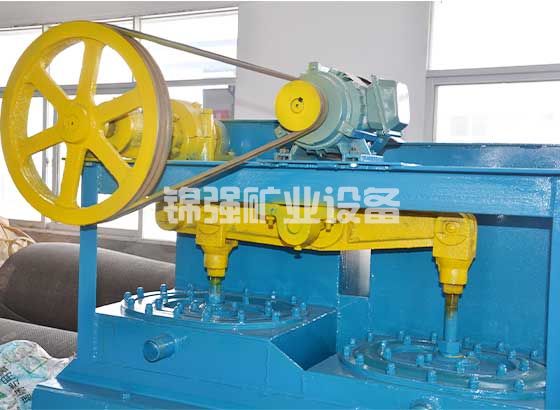Common faults of jigs
1. Sieve plate damage:
The sieve plate is impacted by coal and water, and heavy products wear along the sieve surface, causing the sieve plate to rupture or perforation. In this case, immediately stop repairing or replacing the sieve plate.
The second is the clogging of the sieve holes.
The reason for the blockage of sieve plate holes is that there are many materials with particle sizes between this aperture in the selected materials, and attention should be paid when selecting the sieve hole size.
When the sieve hole blockage is not severe, it can be washed with strong wind and small water after normal parking, or the bed layer can be set thinner during driving, and the sieve plate can be crushed with an iron pipe or rod; If the blockage is severe, it should be stopped immediately and the sieve plate cleaned, otherwise it will affect the sorting effect.
Sieve plate edge pressing (guard plate edge pressing) or loose screws.
If the situation is not serious, the bed can be cleaned and treated during normal parking; If the situation is serious, stop immediately.

Fourthly, there is a change in the inclination angle of the sieve plate.
When cleaning the sieve plate and handling clogged sieve holes every day, improper methods and methods can cause the sieve frame to sink or deform, as well as the sinking or deformation caused by the impact of coal and water transmitted to the sieve frame. This situation is generally not easy to detect and requires regular inspection. If the situation is serious, it needs to be adjusted.
Secondly, the air valve of the jig is faulty.
Spray water from the exhaust port of the air valve.
The reasons for this phenomenon may be high wind pressure, thick bed, or clogged sieve plate holes.
Secondly, the stroke of the air valve is insufficient.
The reasons for this phenomenon may be improper CNC adjustment, insufficient air pressure, damaged air valves, etc. It is necessary to identify the cause and handle it in a timely manner, otherwise it will affect the sorting effect.
3. The action of the air valve is not coordinated with the numerical control.
The cause of this phenomenon may be a malfunction of the solenoid valve or improper circuit wiring. At this point, it is necessary to handle it in a timely manner.
Jig float malfunction (float not moving)
A common malfunction is the wear of the buoy, and the mechanical part of the buoy is stuck by garbage. This situation can also occur if the bed is too dead. This requires identifying the cause and targeted treatment.
Fourthly, the solenoid valve is faulty.
There is no sound absorption after the electromagnetic block is powered on.
The reason is: poor wiring contact or coil disconnection. To properly wire, replace the coil.

The electromagnetic block emits a buzzing sound.
The reason is that there are debris between the moving iron core and the static iron core; Poor sealing under the movable iron core; The voltage is below the allowable value. At this point, it is necessary to clean the iron core; Repair or replace the sealing gasket; Adjust the voltage.
3. The electromagnet and exhaust hole are leaking;
The reason is that the sealing or upper sealing gasket of the movable iron core is damaged and needs to be replaced at this time.
4. Reversal failure or exhaust leakage.
The reason is that the air source and pressure are lower than the rated value; Hole blockage; The cylinder sealing ring is broken. Treatment method: Check whether the gas source pipeline is leaking; Dredge the exhaust hole and replace the sealing ring; Check the cylinder and replace the sealing ring.
Fifth, the discharge of the jig is faulty.
The discharge outlet of gangue is the main malfunction of the jig discharge, which is mainly caused by the raw coal particle size exceeding the upper limit; It may also be iron debris in the raw coal. When the discharge outlet is blocked, the vertical gate should be closed to prevent coal from escaping, and the actuator should be operated to assist in the discharge. After troubleshooting, it should be transferred to normal operation. When the stuck gangue is severe, it should be immediately stopped and cleared; Damaged automatic discharge devices should be repaired immediately before driving.
In addition, pressure often occurs in the discharge hopper, mainly due to improper operation, excessive discharge, or delayed detection of bed emptying. Of course, there are also equipment reasons, such as loose buckets, chain plate starting, and severe wear of square wheels.
Sixth, flip the bed.
Due to uncomfortable exhaust regulation, the size of the exhaust valve and the intake valve are broken, and flowers may bloom on the bed. This requires immediate identification of the cause and elimination of the danger.

Seventh, the jig box is broken.
Box rupture is one of the common faults of jigs. At this point, phenomena such as wind and water leakage can occur. The problem of water leakage is generally easy to solve, but the problem of air leakage is difficult to solve.
When the air chamber or partition board ruptures, abnormal changes will occur in the bed layer. At this point, only after parking and discharging materials can people enter the body, identify the cause, and troubleshoot.
The setting of the bed layer does not match the actual situation.
In this situation, the zero position of the bed layer setting is generally not determined.
Ninth, abnormal emptying of the bed.
At this point, it is generally due to significant wear and tear in the discharge channel gap, or due to the discharge gate opening being too large, the baffle (or door curtain) at the discharge outlet is supported by an object and not reset, or it is emptied due to the baffle falling off.








